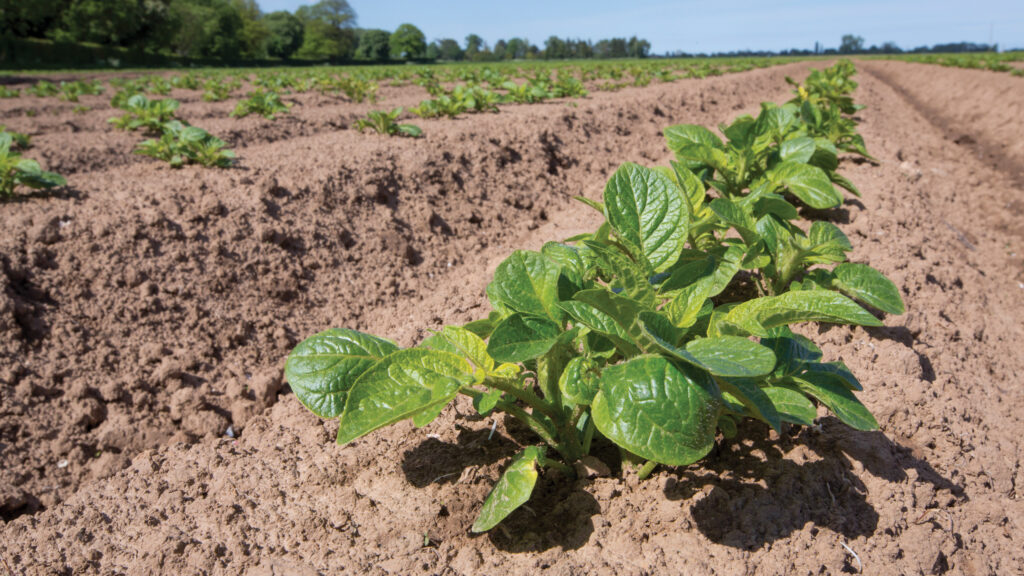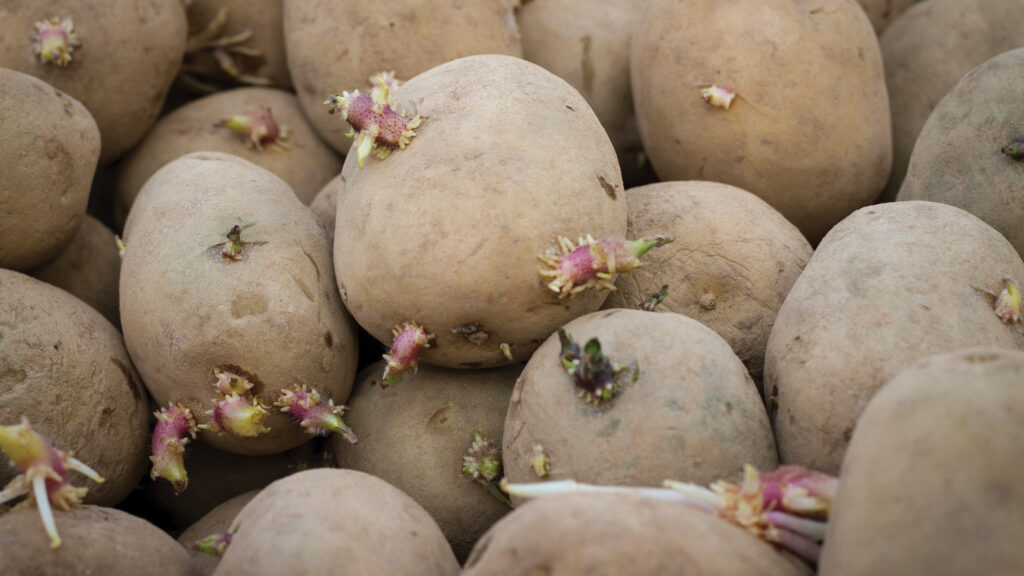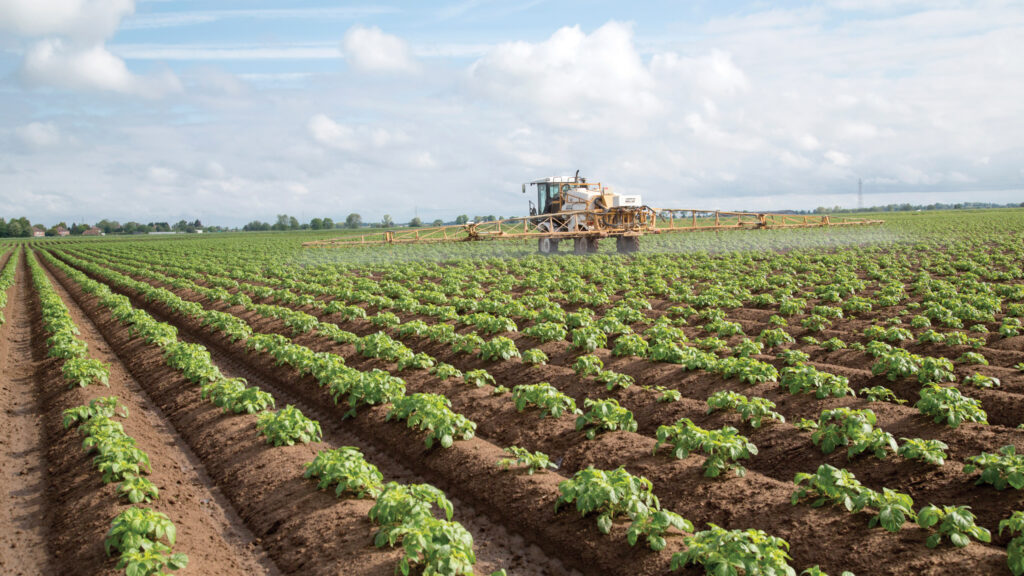Research reveals critical two-month period for potato yields
 Crops under early season water stress had a lower bulking rate than irrigated crops © GNP
Crops under early season water stress had a lower bulking rate than irrigated crops © GNP Setting up potato crops during the period between planting and the onset of tuber bulking to achieve optimum bulking rates is crucial for maximising potato yields.
This is according to Dyson Farming Research (DFR) potato researcher Dr Christine Jones, who says understanding growth patterns for the canopy, roots and tubers explains why this is vital.
Both canopy and root growth increase during the first half of the growing season, reaching a maximum level halfway through tuber bulking before starting to senesce.
See also: How new technology enables yield mapping for root crops
“That means the crop is dependent on the roots formed at the beginning of the season for water and nutrient uptake,” she says.
Bulking rate
Another key aspect is that tubers add biomass at a set linear rate during the bulking phase, with tuber numbers set before it begins.
“The rate at which bulking starts is the maximum rate it will continue. If it starts slowly, it will continue slowly,” Christine says, explaining why it needs to be influenced prior to onset.
Final yields are governed by the combination of bulking rate and duration. A crop adding 7t/ha a week for 14 weeks theoretically can reach a yield approaching 100t/ha.
But average data across 30 years of DFR – and previously CMI trials in the UK – suggest a more typical bulking rate of 6t/ha a week for just under 10 weeks leads to average yields of about 50t/ha.
Within the data, the highest rate of bulking achieved was about 5t/ha a week, but lasted only for about four weeks.
“From the data, it seems unlikely that crops with very high rates of bulking will do it for very long,” Christine says. “There can be an inverse relationship between the rate and duration of bulking.”
While that crop achieved an above-average yield of 65t/ha, the highest yield of 105t/ha came from a crop of Cara which had a bulking rate of 6t/ha a week for a very long duration of 17 weeks into early October.
But typically, bulking duration is limited by the season length and need to harvest the crop.
That is why it is better to manage crops to increase bulking rate to maximise yields, Christine says.
Two-month period
Influencing that bulking rate happens during the approximately two-month period between planting and the onset of bulking.
In particular, managing the growing environment seed is placed into is vital, with any stresses potentially impacting future bulking rates, Christine says.
Seed size plays a role, with larger seed tubers providing greater energy reserves in the form of carbohydrates for early post-emergence growth. They also supply at least 50% of early nitrogen requirements, along with other nutrients.
Low temperatures at planting depth can slow down remobilisation of those carbohydrates, limiting growth, Christine says.
Too much or too little water will also slow growth, while light intensity is more important earlier in the season than later.
“Growers tend to get worried about dull days in the middle of the season not helping bulking – but it’s more important early, when there are fewer leaves to maximise photosynthetic rates.
“Later in the season, there can be plenty of spare capacity within the canopy.”
Bulking rates can be influenced in this initial period of growth, DFR trials have shown.
For example, crops under early season water stress had a lower bulking rate than irrigated crops, while increasing nitrogen rates to an optimum can increase bulking rates.
Faster bulking crops were also more efficient at using nitrogen, meaning there is potential to reduce N requirements.
“It’s not easy to predict what you need to apply, but if you know you grow more efficient crops, you’ve got more opportunity to reduce applications,” Christine says.
Seed choice helps set yield potential
Seed choice is an important factor in helping set a crop’s yield potential, says Dyson Farming Research’s Dr Christine Jones, with seed size perhaps an under-considered factor.
Larger seed sizes typically produce a greater number of progeny tubers, albeit in a relationship complicated by other factors, including how the seed crop was grown and seed rate.
“We re-analysed some old Adas data from trials looking at seed size that showed you could never achieve the same yields from small seed that you could from large seed,” Christine notes.
“If you double the size or weight of the seed, it doesn’t double the number of stems produced, so each growing stem has more reserves for the tubers produced from it.”
That helps explain why larger seed usually performs better than smaller seed when planted into less-than-ideal environmental conditions, or when stressed by disease infections, achieving better emergence uniformity.
Practically, other than developing a close relationship with your seed supplier to procure the best seed, grading seed into narrow grades could help improve establishment uniformity, which improves ease of crop management.
“You could plant the smaller-sized batch in the best conditions when differences in emergence are likely to be least, while the larger grade can cope better with poorer conditions.”

Large seed can cope better than smaller seed in poorer conditions © GNP
Biostimulants
Another possibility is the use of biostimulants. DFR experiments have shown the importance of understanding how individual biostimulants work.
Some, applied early in the season, may influence the rate of bulking, Christine says.
Others may not show an effect unless stress occurs.
For instance, in some experiments where heat stress occurred mid-season, bulking rates were reduced, but the reduction was significantly less in treated than untreated plots.
“It’s helpful to know there are products that can help plants cope with conditions we cannot control.
“Ultimately, you’re trying to remove as many constraints as possible in the early part of the season – getting that first part of the season right is really important,” she says.

Applying a biostimulant can help reduce the impact of heat stress on bulking rates © GNP
New meetings format for Dyson Farming Research
Dyson Farming Research has revamped its knowledge exchange meeting programme and membership options to make events more accessible to farmers.
The new format sees a switch to more topic-specific meetings in a shorter duration, making it easier to pick and choose what to attend across the meetings in Lincolnshire, Oxfordshire and online.
Future meetings this year include:
- Machinery management advice
- Making informed variety decisions
- Help with Sustainable Farming Incentive
- Harvest trials reviews in potatoes and cereals
- How artificial intelligence and gene editing are shaping the future.
Individual meetings can be attended on a pay-per-meeting basis. There are also membership options, such as a year-long subscription that includes all events.
Material for this article was gathered at a Dyson Farming Research meeting at Nocton, Lincolnshire

